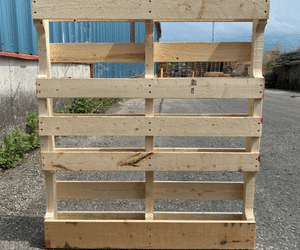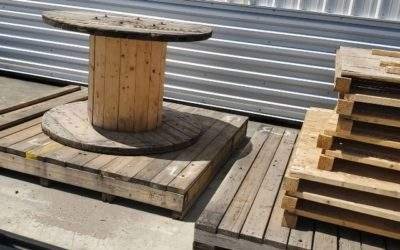There are several considerations to make when deciding between a block pallet and a stringer pallet for your items, despite the fact that many purchasing or shipping managers have a preference for one form of pallet over the other.
Pallets are essential because they protect goods during transport, save labor costs, and keep manufacturers operating. Whether you’re shrink-wrapping, strapping, shipping, or just keeping your goods, pallets are the backbone of your unit load.
Indeed, wood pallets play such a crucial role in the logistics process that picking the right pallet type can either make or break your shipments or even storage. Fortunately, you can pick between two standard options: block pallets or stringer pallets.
Pallets Plus Flint offer solutions for dunnage, affordable dumpsters, wooden crates, steel drums, industrial tanks and wooden wire reels.
What are Stringer Pallets?
As its name implies, a stringer pallet relies on stringers to hold up its load. The stringer pallet dimensions are often 2 by 4s or 3 by 4. They’ve been crammed between the deck’s top and bottom boards.
The length of the stringer pallet is typically listed first when describing its dimensions. Next comes the length or width, which will be mentioned afterward.
Pallets made from stringers sometimes have notches cut into them to facilitate 4-way loading. Thus, a 4-way stringer pallet was developed.
Any pallet with the stringers left unnotched is considered to be a 2-way pallet. Typically, they only have forks at one end for access. Bottom deck planks can be chamfered to make room for a pallet jack’s wheels.
What are Block Pallets?
The wood block pallet is an actual, genuine 4-way entry pallet. They will sustain the weight of your device with blocks of wood, plywood, or plastic. The deck boards of a block pallet are usually supported by anything from four to twelve blocks.
A block pallet’s length is also determined by the stringer board’s length, much like with stringer pallets. The length of deck planks determines their width.
Block pallets can be designed with or without perimeter base and bottom deck boards. For wood pallet dimensions, consider each corner, each side, and the center of the pallet must have a hardwood block to sustain the unit load, for a total of nine blocks in a standard block pallet.
What is the difference Between Block Pallet vs Stringer Pallet?
The type of support that is utilized between both the top and bottom layers of the pallet is the primary distinction that can be made between stringer and block pallets.
Stringer pallets are linked together through three boards measuring two by four, with one board running along either side of the pallet and the third board running across the middle.
These are the stringers which give the pallet its name. They typically have notches cut in them so that a forklift can enter the pallet from any of the four directions.
The blocks on a block pallet are four inches by four inches and hold the pallet together. Sometimes there are additional planks around the edge of the pallet that reinforce both of the top and bottom decks.
The stringer pallet, including its straightforward utilitarian design, has endured into the present day as one of the most prevalent types of pallets, and the odds are good that this is the design that most people picture in their heads when they hear the term “pallet.”
It’s possible that this is due to the fact that these are the types of pallets that do-it-yourselfers and upcyclers typically utilize in their projects.
They are not very durable, and their production ensures that they will only survive a number of cycles in the supply chain prior to getting thrown away.
Because stringer pallets are only durable enough to go in one direction along the supply chain, they have a tendency to accumulate behind shopping centers, supermarket stores, and warehouses.
Companies that use “one and done” stringer pallets are required to continually replace their older stringer pallets using new ones in order to keep supply chains operational.
The construction of block pallets, in contrast, hand, requires more wood because they are intended to withstand greater amounts of wear and tear than standard pallets.
They also have a far larger number of nails, each of which is substantially more substantial than the nails found in stringer pallets.
The finished product is a robust and fully 4-way pallet that is capable of making far more journeys through the supply chain than its stringer-based predecessor.
However, because the block pallet is so sturdy, it results in a large increase in both the amount of weight and the amount of fuel that is required to move the blocks.
Stringer Pallets vs Block Pallets Uses
Although stringer pallets have inferior durability compared to block pallets, their low cost attracts the attention of many supply chain managers.
A stringer pallet weight is quite less than a block pallet, and its affordable nature makes it an optimum platform to utilize when sending a partial unit load to a region of the supply chain where hauling the pallets back is impractical.
Conversely, block pallets are really the best option in most cases. If you’re a heavy goods shipper with a multi-step supply chain who cares about minimizing wasteful materials and rejected loads, you might want to explore switching to block pallets instead of stringers.
Conclusion
The benefits of using wooden pallets can be realized by supply chains with the implementation of a wooden pallet pool method with minimal additional work.
These wooden pallets coordinate pallet shipping and storage. Doing so will guarantee that they will be accessible at the precise moment of need.
Pallet options have expanded beyond just block pallets versus stringer pallets. Strong wooden pallets, in the end, provide an option that is preferable to other pallets.
FAQs
What is a stringer pallet?
The most popular type of pallet in the USA is a stringer pallet because stringers are used to hold up the load. The stringers, commonly constructed from 2 x 4s or 3 x 4s, are the boards situated between the deck boards.
Are block pallets stronger?
Typically, the capacity of block pallets is higher than that of stringer pallets, and they may be accessed from all four sides. Block pallets are recommended for shipping and handling heavy goods due to their increased strength and stiffness.
What is a stinger on a pallet?
Stringers are the planks located between the top and bottom deck boards.
What are the two types of pallets?
There are two main types of palettes, a single-face, and a double-face. Decks can be seen on both the top and bottom of double-face pallets. The bottom deck adds to the durability of the pallet and assists in spreading the load’s weight throughout the board.







0 Comments